May 2022
May 31, 2022
The Society for the Prevention of Progress
Marine biologist Joel Hedgpeth founded the Society for the Prevention of Progress in 1945. He was its sole member. According to his obituary in the Journal of Crustacean Biology: "Many a grad student and junior colleague wanted to join this august club, but Joel refused applications—growth in members would represent progress."However, there were exceptions to his no-membership policy. For instance, Hedgpeth wrote to C.S. Lewis inviting him to become a member.
The initial inspiration for the Society seems to have been to protect the environment against the "encroachment of material civilization." The Society's statement of purpose (below), as well as the Society letter-head Hedgpeth had printed up, reflected this intent.
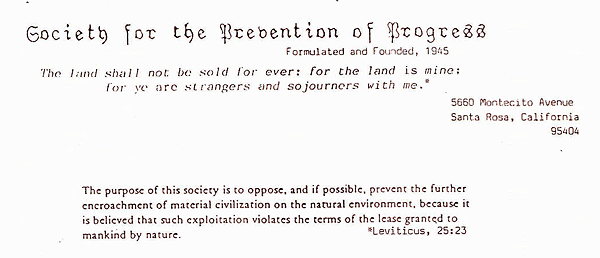
However, Hedgpeth evidently also intended his Society to embrace a much broader spirit of contrarianism, as seen in the manifesto outlined in the article below.
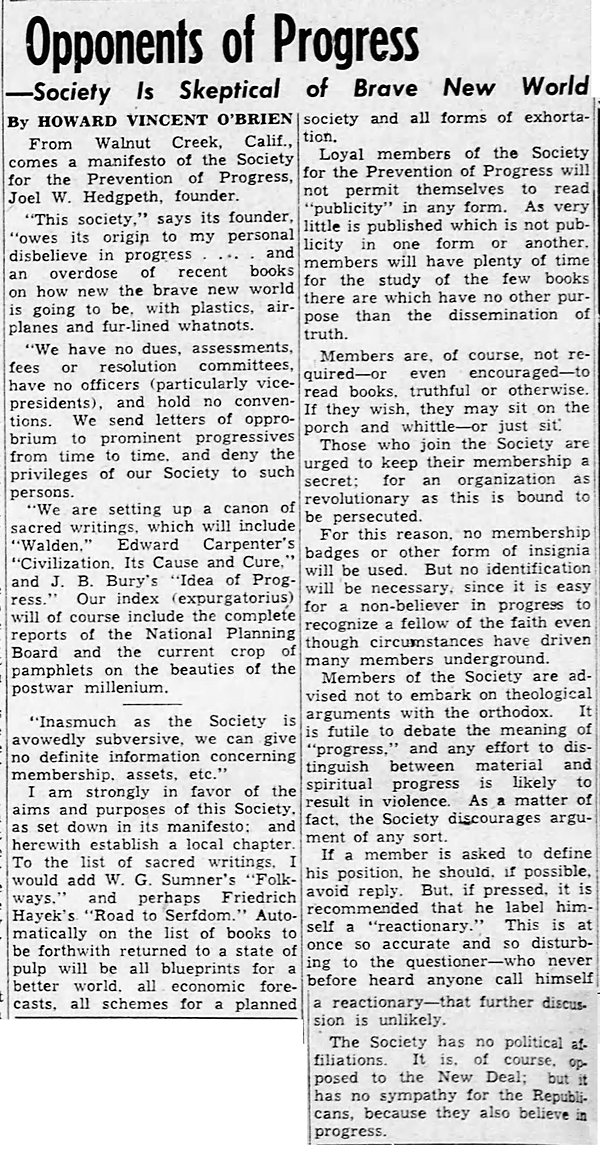
Decatur Herald - Feb 15, 1945
Posted By: Alex - Tue May 31, 2022 -
Comments (1)
Category: Clubs, Fraternities and Other Self-selecting Organizations
Burglary Party
Our Glorious Founder Chuck Shepherd frequently featured reports of housebreakers who a) did housework; b) drank themselves into a stupor; c) cooked a meal; d) had a bath or shower; etc. Here's a variation on the theme.Source: Wichita Falls Times (Wichita Falls, Texas) 30 Jun 1953, Tue Page 1
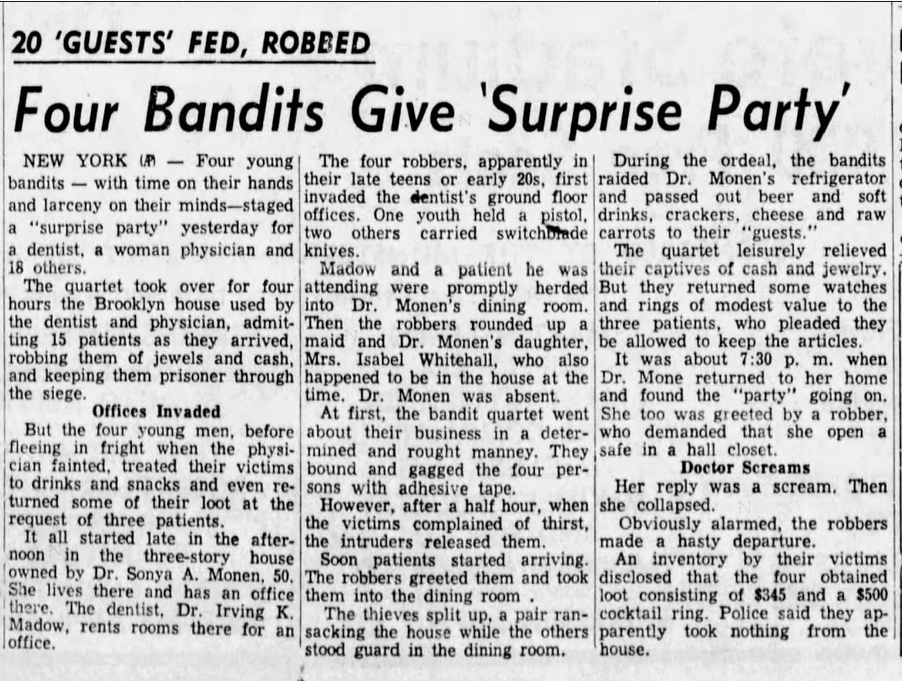
Posted By: Paul - Tue May 31, 2022 -
Comments (2)
Category: Dinners, Banquets, Parties, Tributes, Roasts and Other Celebrations, Food, Stupid Criminals, 1950s
May 30, 2022
Anthropometry of Airline Stewardesses
The research study "Anthropometry of Airline Stewardesses" consists of detailed body measurements of 423 stewardess trainees. It was paid for by the FAA and released in March 1975. The trainees were from the American Airlines Stewardess Training Academy in Fort Worth, Texas.The justification for the study was that knowing the body measurements of stewardesses might help engineers design better seats and safety equipment for them. But what the study really seems to demonstrate is that in the early 1970s airline stewards were expected to be young, thin, female, and single. None were older than 28. None weighed more than 145 lb. Only 26 were divorced. The rest had never been married.
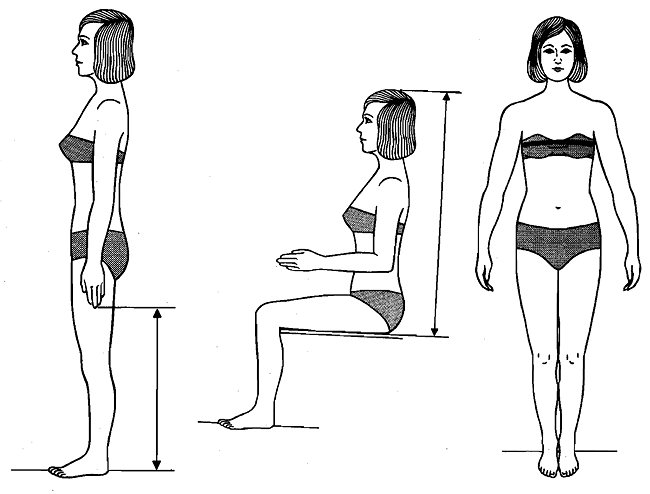
The study attracted the scorn of Senator William Proxmire. Details from a Reuters article in The Calgary Herald (Aug 21, 1975):
Senator William Proxmire says the disclosures neither enlighten nor amuse him.
The Wisconsin Democrat said today the report, with detailed measurements on 423 stewardess trainees for American Airlines, was another case of taxpayers' money spent on discovering the obvious. "It seems like a bust to me," he said...
Seventy-nine individual body measurements were taken as part of the study, and some, the senator said, seemed unnecessary or irrelevant.
"Detailed measurements were made of body features such as the skinfold of the upper arm and the posterior calf, the vertical height of the sphyrion, the popliteal length of the buttocks, the transverse distance between the centres of the anterior superior iliac spines, the knee-to-knee breadth while sitting, the maximum horizontal width of the jaw across the gonial angles, and the height of the nose," he said.
There were too many deviations among even general measurements of young trainees to help designers of airline equipment, he argued.
Their weights ranged from 94 to 145 pounds, heights from five feet one inch to six feet one inch, busts from 29 to 37.5 inches and waists from 21 to 28 inches.
The senator concluded: "About all that can be said to aircraft designers is that stewardesses are young women with the body measurements of young women."
Posted By: Alex - Mon May 30, 2022 -
Comments (5)
Category: Body, Science, Air Travel and Airlines, 1970s
In The Blink Of An Eye: A James Bond Fan Film
Posted By: Paul - Mon May 30, 2022 -
Comments (1)
Category: Movies, Spies and Secret Agents, Homages, Pastiches, Tributes and Borrowings, Children, Twentieth Century, Twenty-first Century
May 29, 2022
Ed Haberman, collector of oil rags
Ed Haberman of Tama, Iowa collected oil rags. The kind used in garages to clean oil dip sticks. He started collecting them in 1956, and by the time he died in 1988 he had over 1300 of them.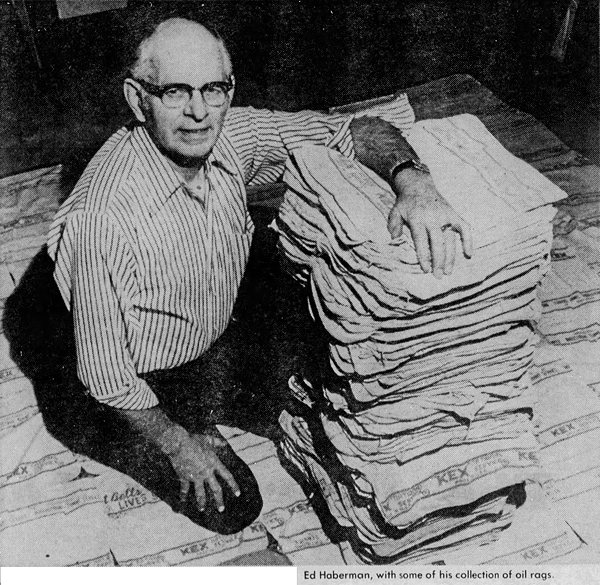
Quad City Times - Feb 4, 1973
In 1968, he talked about his collection to a reporter from the Des Moines Register (Nov 10, 1968):
"I kept exchangin' dirty oil rags for clean ones at Wilkinson's," he says. "Pretty soon, I decided I needed more than one rag. I guess it was when I had about nine oil rags that it suddenly occurred to me to collect them. Pretty soon, I was watchin' for discarded oil rags all the time — you can find them almost anywhere. When I'd find one, I'd take it back to Tama and exchange it for a clean, new one."
There is little rhyme or reason to Haberman's method. For example, he quickly discarded the idea of keeping dirty oil rags because his wife, Eleanor, 52, would have none of it.
"I don't even care much for his CLEAN oil rags," she said last week. "In fact, I think the whole idea is pretty stupid. It gets pretty nerve-racking when we're out on a trip and he keeps stopping the car every time he sees a dirty old oil rags. But I guess as long as he keeps them in a neat pile and out of my way, it's all right."...
"People come to my basement," Haberman says, "Look at my pile of rags and just stand there laughing. I know they're probably laughing at me, but I don't care. Really, I don't. They don't understand. I just laugh along with them. But, all the time, I know I've done something no one else has.
"It's important for a man to accomplish something. For me, it's collecting oil rags. I happen to enjoy doing it."
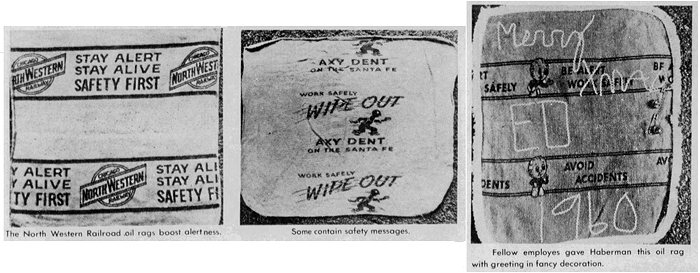
Quad City Times - Feb 4, 1973
Posted By: Alex - Sun May 29, 2022 -
Comments (3)
Category: Collectors
Ánnámáret: Homegrown Concert
"Ánnámáret is the performing name of Sámi musician Anna Näkkäläjärvi-Länsman. Ánnámáret performs yoik, a distinctive singing and songwriting tradition of the Sámi people."
The actual singing begins at the six-minute mark. Let us know how much you enjoy yoik music.
Posted By: Paul - Sun May 29, 2022 -
Comments (2)
Category: Music, Foreign Customs, Cacophony, Dissonance, White Noise and Other Sonic Assaults
May 28, 2022
Greasy Kid Stuff
Television commercials for Vitalis hair tonic during the 1950s and early 60s included the line, "Are you still using that greasy kid's stuff on your hair?In 1962, this inspired two young entrepreneurs to come out with a hair product called "Greasy Kid Stuff".


Charlotte Observer - Feb 15, 1963
It enjoyed brief popularity as a fad product, but within a year had disappeared from shelves.
But the phrase 'greasy kid stuff' also inspired both a song that became a Top 40 hit and (in the 1990s) a popular radio show.
More info: Ad Nauseam
Posted By: Alex - Sat May 28, 2022 -
Comments (0)
Category: Music, Advertising, 1960s, Hair and Hairstyling
Jazz Poetry
The Wikipedia entry, followed by some examples from the Boston Post, 09 Jan 1921, Sun Page 53.
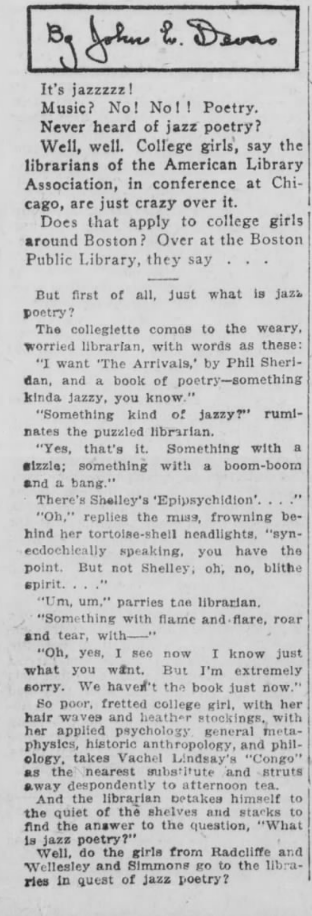


Posted By: Paul - Sat May 28, 2022 -
Comments (1)
Category: Fads, Music, Poetry, Bohemians, Beatniks, Hippies and Slackers, 1920s
May 27, 2022
Steel Mill Archery
My mother's family lived in the Pittsburgh area, and a lot of them (including my great-grandfather) worked in the steel mills. But I hadn't known that the mills employed archers to ignite the gas coming out of the tall bleeder stacks.
Shenandoah Evening Herald - Dec 29, 1975
Posted By: Alex - Fri May 27, 2022 -
Comments (1)
Category: Jobs and Occupations, Industry, Factories and Manufacturing, 1970s
DisinHAIRited

Almost inevitably, the huge success of Hair on Broadway meant there would be another cast album that would include some of the songs which had been left out of the original album, all the more reason since they were more pop tunes than theatrical arias, and therefore easier to play on the airwaves. DisinHAIRited was such a recording. It provided a better picture of the score created by James Rado, Gerome Ragni and Galt MacDermot, as performed by the original cast, and was a deft complement to the first album. Recorded a year and a half after the show opened on Broadway, it also featured some new tribal members, including Sakinah, Robin McNamara and George Tipton, who had joined the cast in the intervening months. First LP Release: December 17, 1969
Posted By: Paul - Fri May 27, 2022 -
Comments (2)
Category: Music, Lost, Newly Discovered, Cutting-Room-Floor, and Discarded Cultural Items, 1960s
| Get WU Posts by Email | |
|---|---|

| Who We Are |
|---|
| Alex Boese Alex is the creator and curator of the Museum of Hoaxes. He's also the author of various weird, non-fiction books such as Elephants on Acid. Paul Di Filippo Paul has been paid to put weird ideas into fictional form for over thirty years, in his career as a noted science fiction writer. He has recently begun blogging on many curious topics with three fellow writers at The Inferior 4+1. Chuck Shepherd Chuck is the purveyor of News of the Weird, the syndicated column which for decades has set the gold-standard for reporting on oddities and the bizarre. Our banner was drawn by the legendary underground cartoonist Rick Altergott. Contact Us |

